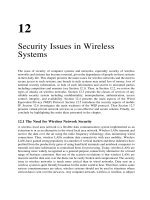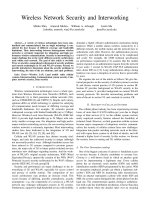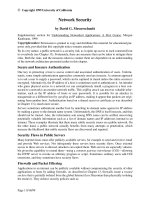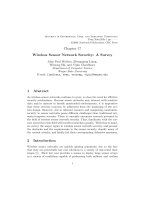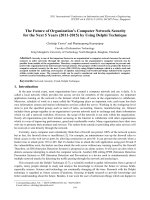Wireless Network Security Issues BY Ashwani Kush & Ram Kumar pot
Bạn đang xem bản rút gọn của tài liệu. Xem và tải ngay bản đầy đủ của tài liệu tại đây (41.51 KB, 6 trang )
Wireless Network Security Issues
Ashwani Kush & Ram Kumar
Abstract
In the time span of just a few years, wireless networking has emerged from a
novelty to revolution. The speed with which wireless networking has caught on is
not surprising owing to large bandwidth and range of several hundred feet.
Moreover multiple wireless access points can be easily installed on same
network to cover more areas. Our main challenge in design of these networks is
their exposure to security attacks. Routing protocols for wireless networks are
still an active research area. There is no single standard routing protocol.
Therefore we aim to consider common security threats into account to provide
guidelines to secure routing protocols. In this paper a study has been carried out
for the threats on wireless networks and security goals to be achieved.
1. INTRODUCTION
The advent of wireless networking has
raised some very compelling issues. Most
important are security issues.
1,2
Other issues
can be legal and social. Since their
emergence in the 1970s, wireless networks
have become increasingly popular in the
computing industry. This is particularly true
within the past decade which has seen
wireless networks being adapted to enable
mobility. Wireless networks are emerging fast
as latest technology to allow users to access
information and services via electronic media,
without taking geographic position in account.
Mobile hosts and wireless networking
hardware are becoming widely available, and
extensive work has been done recently in
integrating these elements into traditional
networks such as the internet. Wireless
networks have taken the world by storm.
Enterprises and people using computer at
home are avoiding the expenses and delays
associated with installing wired networks.
High speed internet facility is enjoyed by
travellers all over the places worldwide. Along
with increases in throughput, wireless
networks remain unlicensed and affordable.
This has further helped their exponential
growth in businesses, homes, communities
and open spaces. There are currently two
variations of mobile wireless networks. The
first is known as infrastructured networks, i.e.,
those networks with fixed and wired
gateways. The bridges for these networks are
known as base stations. A mobile unit within
these networks connects to, and
communicates with, the nearest base station
that is within its communication radius.
Typical applications of this type of network
include office wireless local area networks
(WLANs). The second type of mobile wireless
network is the infrastructure less mobile
network, commonly known as an ad-hoc
network. A ‘mobile adhoc network’
3
is an
autonomous system of mobile hosts which
are free to move around randomly and
organise themselves arbitrarily.
2. NEED OF SECURITY
Over a decade or so there has been
tremendous changes in the way people
communicate. Description of computing
device has changed from PC to
communication systems, PDAs, smart phones
DESIDOC Bulletin of Inf Technol, 2005, 25(1) 13
DESIDOC Bulletin of Information Technology , Vol. 25, No.1, January 2005, pp. 13-18
© 2005, DESIDOC
and so on. Moreover there are over one
billion subscribers using mobile phone
technology as opposed to the number of PCs
installed. The new computing devices have
the capacity to transmit data in its varying
forms, not only to similar devices, but also to
different devices across a network. Mobile
internet and mobile network are reality now.
The convergence of technologies has made
the devices and the network upon which they
operate, more interchangeable than ever
before with their overlapping applications. The
market is also using latest technology as in
E-Commerce which uses B2B (Business to
Business), B2C (Business to Consumer),
G2G (Government to Government) and G2C
(Government to Citizen) all requiring data
exchanges. Also some private communication
systems like VPN (virtual private network) and
VPA (virtual private access) uses a lot of
communication between two networks.
According to IDC sources, Global internet
commerce is expected to hit US$ 1 trillion by
the end of 2004. With so much abundance of
networking, it is becoming more and more
needful to have a secured transmission and
so security has become a major element in
both hardware and the application software. It
is being argued that, though a high degree of
transmission is already in process, the
number would be much greater if data
security could be guaranteed. To ensure
future growth of markets and their
applications, a high degree of security is
required, due to potentially high commercial
value of both the business and private data is
being submitted. The need for security arises
due to:
³
Growth of mobile internet access and
applications,
³ Individual user requirements, and
³
Corporations (business or governmental)
who both require internal and external
contact and data transfer through remote
places.
3. SECURITY ISSUES
Security is an important issue for wireless
networks, especially for those security
sensitive applications. Many users of data
transmission devices (such as laptops, PDAs,
PCs, phones, etc.) demand for Protecting
data residing within devices, protecting the
transmission network, protecting transfer of
data, and ensuring proper transfer. One of the
goals of current wireless standard was to
provide security and privacy that was ‘Wired
equivalent’ and to meet this goal, several
security mechanism were provided for
confidentiality, authentication, and access
control.
4,5,6
Unfortunately all of these can be
easily broken.
7,8
Points to consider as security
parameters are:
(a) Identity: An essential element in any
security system is reliable, robust
non-malleable identity.
(b) Access control: Access control is the
constraint that limits those who can utilize
system resources. Two approaches are
used, one is called ‘access control list
(ACL)’ and other as ‘closed network’.
(c) Authentication: It ensures that
communication from one node to other is
genuine. Only legitimate users can access
the system and services. Two used
systems are ‘open system’ and ‘shared
key’.
(d) Availability: Availability ensures the service
offered by node will be available to its users
when expected, in spite of attacks. Also
only legitimate users can access data
anytime.
(e) Integrity: It protects nodes from maliciously
altered messages.The receiver wants to be
sure that the source is genuine. It assures
the data, system or platform has not been
tampered with.
(f) Non repudiation: It ensures that the origin of
the message cannot deny having sent the
message.
(g) Confidentiality: It ensures that certain
information is never disclosed to
unauthorized entities. Personal or sensitive
data is protected.
4. ATTACKS
There are two types of attacks toward
security protocols: (a) External and (b)
Internal.
14 DESIDOC Bulletin of Inf Technol, 2005, 25 (1)
4.1 External Attacks
External attacks can be passive and
active. Passive attacks are unauthorized
interruption of the routing packets and active
attack is from outside sources to degrade or
damage message flow between nodes.
4.2 Internal Attacks
A compromised node is categorized as
internal attack. This is most severe threat for
adhoc networks. This may broadcast wrong
routing information to other nodes
The inheritance feature of wireless
networks poses opportunities for attacks from
passive eavesdropping to active
impersonations, and message distortion. As is
often the case, proper security may not be
built in at the beginning.
Active external attacks on the wireless
routing protocol can be described as
denial-of-service attacks, complete break in
communication between nodes or degrading.
One type of attack involves insertion of
extraneous packets into the network which in
turn causes congestion. Another attack
involves intercepting a routing packet,
modifying its contents, and sending it back
into the network or to replay it back to the
network at different times, introducing
outdated routing information to the nodes.
One of the attack is called ‘man in the middle’
means intervention of a third party within
communication path without knowledge of
source and receiver. Another is ‘woman in the
middle’ means one of the parties (source or
receiver) is replaced by attacker.
5. SECURITY MODELS
5.1 Virtual Private Network (VPN)
This offers a solid solution to many
security issues, where an authenticated key
provides confidentiality and integrity for IP
(internet protocol) data grams. Software are
available to implement VPNs on just about
every platform. Authentication depends upon
three factors which are password,
fingerprints, and a security token. Using two
factors is desirable and using all three is most
secured. VPN only supports IP so it cannot
be solution for all environments.
5.2 Encryption
Encryption is a technique used for many
years for passing information from one place
to other in a secured manner. A message in
its original shape is referred to as a plaintext
(or text) and a message used to conceal
original message is called ciphertext (or
Cipher). The process of changing plaintext
into ciphertext is called encryption and the
reverse process is called decryption. There
are many algorithm available for these
processes. Some of them are Data
Encryption Standard (DES),
9
International
Data Encryption Algorithm (IDEA)
9
and Public
Key Algorithm (RSA).
10
These are based on
key based algorithms. There is one popular
key algorithm known as Digital Signature
algorithm.
11
In Digital signature, signer
encrypts the message with key, this is sent to
recipient, the message is then decrypted with
sender’s public key. In case of ad hoc
networks this may not be the best method as
it uses a lot of space and is also slow.
5.2.1 One Way Hash Function
There is another algorithm called ‘One
Way Hash Function’.
12
It is like checksum of a
block of text and is secure because it is
impossible to generate the same hash
function value without knowing the correct
algorithm and key. It accepts a variable size
message and produces an affixed size tag as
output. This algorithm can be combined with
encryption to provide an efficient and effective
digital signature.
5.2.2 Digital Signature
External attacks can be checked using
confidentiality of the routing information and
also by authentication and integrity assurance
features. Encryption can be solution to this.
Digital signatures and one way functions can
be applied.
13
Perlman
14
used complex
robustness to protect routing data from
compromised nodes. It is ability to continue
correct operation in presence of arbitrary
nodes with complex failures.
DESIDOC Bulletin of Inf Technol, 2005, 25(1) 15
5.3 Mobile Security Solutions
In mobile security, the solutions which are
in use are: PKI system (Cryptographic Key
System), Silicon-based Security (as hardware
security), SIM Card Security, UICC (Universal
Integrated Circuit Card), RFID (Radio
Frequency Identification), Secure Mobile
media on mobile devices, WAP portals, Dual
slot phone, Blue tooth, and Biometrics.
Authentication can be done using biometric
security, external tokens, cryptographic
co-processors, firewalls and software security
programs.
Most security models only secure one of
the four elements, rather than all which are:
secure authentication, confidentiality-privacy,
integrity, and data availability .
Security lapses lead to collection,
exploitation, falsification, and destruction of
data or transactions.
6. RELATED WORK
6.1 Secure Routing
Secure routing in networks such as
internet has been very widely studied.
15-20
These routing protocols proposed, cope well
with dynamically changing topology. However
none of them, to the best of our knowledge,
have mechanisms to guard against malicious
attacks. To deal with external attacks,
standard schemes like digital signatures are
used to protect authenticity and integrity.
Kumar
16
considers problem of compromised
route as a hard problem, but suggests no
solution to it. Also Sirios and Kent
19
gave idea
of one-way hash function with windowed
sequence number for data integrity and also
use of digital signatures. Perlman
14
gives idea
of how to protect routing information from
compromised routers in the context of
Byzantine robustness. It only analyses
theoretical feasibility under some
assumptions. Murphy and Garcia,
17
Sirios and
Kent
19
and Smith and Murphy
20
gave only
partial solutions to the problem. They give the
basic idea to detect inconsistency using
redundant information and to isolate
compromised routers. Smith and Murphy also
gave the idea to secure distance vector
routing protocol for ad hoc networks, the
method suggested is to add extra information
of a predecessor in path to destination in the
routing table. They suggest using this
information, correctness of path can be
verified by path traversal technique. Though it
adds cost factor and is mostly avoided.
6.2 Security in Wireless Networks
An authentication architecture for mobile
ad hoc networks is proposed by Jacobs and
Corson.
21
This architecture can accommodate
different schemes. Another authentication
architectures include X.509 standard,
22
Kerberos.
23
These are based on certificate
authority (CA) but these are not very suitable
for ad hoc networks because of infrastructure
less support by ad hoc networks, dynamic
topologies, frequent route changes. Another
model, a slight variation of these models
called Hierarchical exist but it also does not
address issues like robustness and service
availability.
PGP trust model follows a ‘web of trust’
authentication model. This also is not
successful, because it is difficult for each
node to maintain a long list of trusted friends.
6.3 Threshold Secret Sharing
Threshold secret sharing serves as
primitive in many security function areas in
literature of security functions. Much literature
is available in this area
25-29
Threshold sharing
leads to need of defending against
compromised servers. Fox and Gribble
30
propose a Kerberos-based authentication.
Zhou and Haas
31
proposed “securing ad hoc
networks“ applies the threshold secret sharing
and proactive secret share update schemes
in a fixed group of special nodes. Another
paper from Luo, Zerfos Kong, Zhang from
UCLA, Los Angeles, CA proposed a “self
securing ad hoc wireless network“ which
claims the model to be almost perfect in
assumed conditions. They highlight the
features as: system does not expose to any
single point of compromise, single point of
denial of service attack, or single point of
failure. The model sales to large network size
and is robust against wireless channel errors.
Though the model handles only node
16 DESIDOC Bulletin of Inf Technol, 2005, 25 (1)
authentication but can be applied to user
authentication as well. It uses cryptographic
primitives RSA .
6.4 Complex Robustness
Perlman
14
used complex robustness to
protect routing data from compromised
nodes. It has ability to continue correct
operation in presence of arbitrary nodes with
complex failures.
6.5 Distributed Key Management
It involves designation of a set of
‘Trustworthy’ nodes that share sections of the
public key of the management system. Each
trusted node keeps a record of all public keys
in the network. The number of nodes needed
to generate a valid signature is less than the
total number of trusted nodes. The solution is
called ‘Threshold Cryptography’.
7. CONCLUSION
As wireless networks are becoming more
sophisticated and also offering more
applications, number of security sensitive
areas will appear depending on number of
interfaces. There are a number of security
efforts underway currently from both
manufacturers and users, but still none of the
individual security feature can encompass the
meaning of security as a whole. Security
measures should be categorized as:
Technical, logical, organizational, procedural
and physical by tactics which are preventive,
detective, repressive and corrective. Active
attacks can be checked via authentication
and integrity assurance services. External
attacks can be checked via confidentiality or
routing information and encryption. Also
digital signatures or one way function can be
solutions. The security services required to
combat these active attacks are
authentication and integrity assurance.
Authentication of routing messages allows
nodes to disregard any information that does
not come from a trusted source. The integrity
of a message will avoid a node from using
any information that has been modified in
transit. External attacks can be checked using
Confidentiality of the routing information and
also by authentication and integrity assurance
features. Encryption can be solution to this.
Digital Signatures and One Way Hash
Functions can be applied.
What is needed is a variety of security
elements with external security tokens and
embedded features in IC to create secured
platforms.
REFERENCES
1. Stajano, F.; & Anderson R. The
resurrecting duckling: Security issues for
adhoc wireless networks.
www.cl.cam.ac.uk/~fms27/duckling/duckli
ng.html, April 1, 2000.
2. Smith, B.R.; & Garcia-Luna-Aceves, J.J.
Securing the border gateway routing
protocol. Proceedings of Global Internet
’96, November 1996.
3. National Science Foundation. Research
priorities in wireless and mobile
networking.
www.cise.nsf.gov.
4. Arbaugh, W.A. An inductive plaintext
attack against IEEE 802.11. Working
Group, 2001.
5. Arbaugh, W.A.; & Shankar, N. Your
wireless network has no clothes. In First
International Conference on Wireless
LANs, Singapore, 2001, pp. 131-44.
6. Borisov, N.; & Wagner, D. Intercepting
mobile communications. In Proceedings
of International Conference on Mobile
Computing and Networking, July 2001,
pp. 180-89.
7. Fluhere, S.; & Shamir, A. Weakness in
key schedule algorithm. In Proceedings
of Workshop on Selected Areas of
Cryptography, 2001.
8. Frankel, S. Demystifying the Ipsec
puzzle. Artech House, Boston MA, 2001.
9. Stallings, W. Data and computer
communications. Prentice-Hall, New
Jersey, 1997. pp. 623-64.
10. Gennaro, R.; Jarecki, S.; Krawczyk, H.; &
Rabin, T. Robust and efficient sharing of
RSA functions. Advances in Cryptology
Crypto ’96, Springer-Verlag, Berlin, 1996,
pp.157-72.
DESIDOC Bulletin of Inf Technol, 2005, 25(1) 17
11. Chen, D.; Perez, A.; Sasanus, S.; &
Verma, S. Encryption: Technical and
policy issues.
http://128.138.105.73/capstoneTest/Proc
eedings.asp, Fall 1999.
12. Savard, J. One-way hash functions: A
cryptographic compendium.
/>d/mi0605.htm, April 1, 2000.
13. Smith, B.R.; Murphy, S.; &
Garcia-Luna-Aceves, J.J. Securing
distance-vector routing protocols. Proc.
Symposium Network and Dist. System
Security, Los Alamitos, CA, Feb. 1997,
pp. 85-92.
14. Perlman, R. Network layer protocols with
byzantine robustness. Department of
Electrical Engineering and Computer
Science, Massachusetts Institute of
Technology, 1988. PhD thesis,
15. Rover, E.M.; & Toh, C.K. A review of
current routing protocols for ad hoc
networks. IEEE Communications, 1999,
6, 46-55.
16. Hauser, R.; Przygienda, T.; & Tsudik, G.
Lowering security overhead in link state
routing. Computer Networks, April 1999,
31(8), 885-94.
17. Kumar, B. Integration of security in
network routing protocols. SIGSAC
Reviews, 1993, 11(2),18-25.
18. Murphy, S. & Garcia-Luna-Aceves, J.J.
An efficient routing algorithm for mobile
wireless networks. MONET, October
1996, 1(2), 183-97.
19. Sirois, K.E.; & Kent, S.T. Securing the
Nimrod routing architecture. In
Proceedings of Symposium on Network
and Distributed System Security, Los
Alamitos, CA, February 1997. The
Internet Society, IEEE Computer Society
Press. pp. 74-84.
20. Smith, B.R.; Murphy, S.; &
Garcia-Luna-Aceves, J.J. Securing
distance-vector routing protocols. In
Proceedings of Symposium on Network
and Distributed System Security, Los
Alamitos, CA, February 1997. The
Internet Society, IEEE Computer Society
Press. pp. 85-92.
21. Jacobs, S.; & Corson, M.S. MANET
authentication architecture. Internet Draft
(draft-jacobs-imepauth-arch-01.txt),
February 1999.
22. Aresenault, A., & Turner, S. Internet
X.509 public key infrastructure.
draft-ietf-pkix-roadmap-06.txt, 2000.
23. Kohl, J., & Neuman, B. The Kerberos
network authentication service (ver 5).
RFC-1510.
24. Perlman, B. An overview of PKI trust
models. IEEE Network, 1999, 13(6),
38-43.
25. Gong, L. Increasing availability and
security of an authentication service.
IEEE Journal on Selected Areas in
Communications, June 1993, 11(5).
26. Frankel, Y.; Gemmel, P.; & MacKenzie, P.
Proactive RSA. CRYPTO, 1997.
27. Frankel, Y.; Gemmel, P.; & MacKenzie, P.
Optimal resilience proactive public–key
cryptosystems. FOCS’97, 1997.
28. Gennaro, R.; Jarecki, S.; & Rabin, T.
Robust and efficient sharing of RSA
functions. Journal of Cryptology, 1996.
29. Frankel, Y.; & Desmedt, Y. Parallel
reliable threshold multi signature.
Technical Report TR-92-04-02, Dept of
EECS, University of Wisconsin-
Milwaukee, 1992.
30. Fox, A.; & Gribble, S. Security on the
move: Indirect authentication using
Kerberos. ACM MOBICOM, 1996.
31. Zhou, L.; & Haas, Z.J. Securing ad hoc
networks. IEEE Networks, 1999, 13(6),
24-30.
18 DESIDOC Bulletin of Inf Technol, 2005, 25 (1)
Contributors: Sh. Ashwani Kush, Department of Computer Science, University College,
Kurukshetra, Kurukshetra, 132119. e-mail:
Sh. Ram Kumar, Department of Computer Science & Applications,
Kurukshetra University, Kurukshetra, 132119. e-mail:

